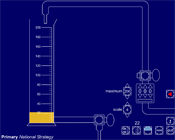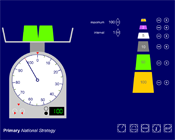Consolidation and practice
These resources are to support children in guided or independent work. Roll over the highlighted resources for a description.
Measuring cylinder

This interactive teaching program (ITP) is an ICT-based tool to support the exploration of number, measures and problem solving. Measuring cylinder ITP allows the child or teacher to simulate varying intervals on a scale, pouring liquid into the cylinder and interpreting the scale. The ITP can be used to explore and consolidate the interpretation and reading of scales, mental calculation strategies and methods of recording.
Measuring scales

This interactive teaching program (ITP) is an ICT-based tool to support the exploration of number, measures and problem solving. Measuring scales ITP allows the child or teacher to add different masses of 1, 2, 5, 10, 50, 100 and 500 units to a scale pan. The scale intervals can be changed to challenge children to interpret different scales.
Opportunities to use and apply
Possible contexts include:
- length, e.g. Work out a route in the school grounds where a kilometre walk could take place.
- length, e.g. Make towers of bricks or boxes that are of a given size (60 cm, half a metre high), make a paper snake 2½ m long.
- mass, e.g. Four potatoes weigh about a kilogram. Approximately how much will 10 potatoes weigh, in kilograms? How much in grams?
- capacity, e.g. A cup holds 200 ml. Work out how many cups can be filled from a 2-litre jug of drink. How many jugs will be needed to fill 30 cups?
Confirming learning
Ask probing questions such as:
- Sort these units into sets for mass, length and capacity, then put each set in order of size of unit. How did you go about this?

- Sort these measurements by size.

How did you know what order they came in? Were there any that were quite difficult to sort out? Provide similar cards for mass and capacity.
- Which would be heavier, 1/2 kilogram or 50 g?
- Can you tell me another way to say 500 ml, 2 kg, 1/4 metre?
 m
m cm = 1/2 m
cm = 1/2 m g = 2 kg
g = 2 kg Measuring
Measuring



